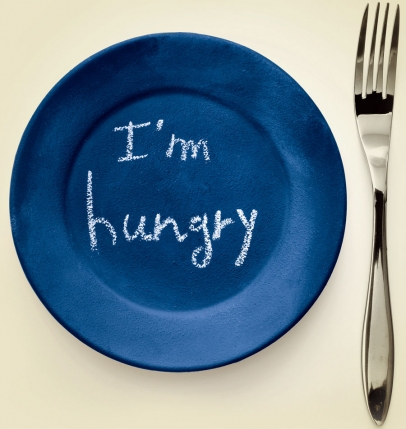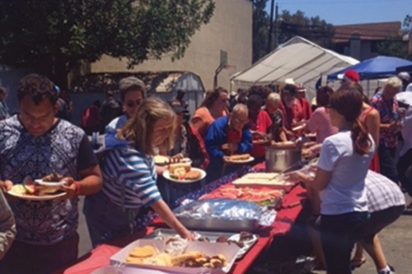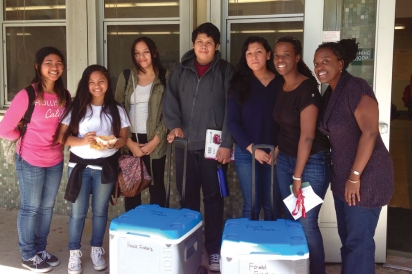Food Recovery: Making Strides to Reduce Hunger in Our Own Backyard
A New Kind of Foodie—Philanthropy Starts in the Kitchen
In 2011, when a little known nonprofit named Food Finders was invited to be a part of a Coalition to reduce hunger in Orange County, there were 1 out of 6 residents going hungry at any given time. Not just homeless people, but children, seniors, college students, and families, many working more than one job. It might have been your next door neighbor who was regularly visiting the local food bank—those who were hungry that nobody really knew about, but constituted part of the 400,000 food insecure people across one of the richest counties in America.
While the hunger issue may have been the focus of a local PBS feature, what was less evident to most people was the enormous amount of excess of food that could have been diverted to local pantries and shelters—rather than being tossed out--to feed people who were struggling to find their next meal. There was still reluctance on behalf of many restaurants, hotels and other food venues to donate, and the reasons for not donating were understandable, but often unsubstantiated.
Logistics—another common concern--was addressed by the system Food Finders already had in place. And finally--storage. How to package food being donated? Who would purchase the materials? But with statewide mandates to reduce and divert waste, increased disposal costs loomed and vendors began to realize the possible savings from simply having a better handle on their inventory and donating what could still be served. Food Finders had already been rescuing and redistributing food surplus, primarily perishable food, for more than 23 years by the time it joined the Waste Not OC (WNOC) Coalition in 2012—which included Orange County Public Health and Environmental Health officials, local restaurants and caterers, food banks and hunger activists—so the voice was now a collective one. Word started to spread that, yes, you can donate food; and even better, it’s simple.
Business owners typically cited liability as their foremost concern. Orange County Environmental Health Services with support from Public Health, began to systematically address the perceived issues through various educational fliers and restaurant inspections. Legislation has been in place statewide that supports food donations to nonprofits, so education the businesses was a priority.
Mike Haller, Program Manager with OC Environmental Health Services, states, “The same laws that govern the health and safety of our food also have provisions for donating food…donating food is not just OK, we encourage it.”
The incredible potential for increasing donors was not lost on the WNOC group. Donations were not limited to just restaurants and caterers, but included any establishment that featured cafeterias, banquet halls or mass meal production. Children’s Hospital of Orange County (CHOC) and Kaiser Permanente, two major healthcare providers, have since joined in the program, along with the Anaheim City School District, Theo Lacy Central Jail system, and the Honda Center.
Four years later, there has been measureable impact made in the county. In just a concentrated area of Orange County, primarily Anaheim, Orange and Costa Mesa, more than 160,000 pounds of donated food have been recovered and redistributed to local nonprofit pantries and shelters, including Lighthouse Outreach in Costa Mesa, which receives food from Sprouts Farmers Market and Kaiser Permanente on a weekly basis.
Lindah Miles with Lighthouse Outreach started feeding the needy and homeless 11 years ago. Food came in spurts initially, and often they were hard pressed to get much more than coffee or rice. By recently partnering with Food Finders, Linda gushes when she shares, “We have amazing breakfast food with eggs and bacon and milk, meat to cook for the elderly on fixed incomes, plus fruits and vegetables that are offered to families in our neighborhood who do not have enough for their children. At this point, Lighthouse Outreach now provides close to 2,200 meals a week, or over 114,000 meals per year.
Waste Not OC plans to engage each city systematically, and with local councils’ support where possible. Meanwhile, Food Finders connects each donor with a local nonprofit agency, keeping the food in the immediate community. But whether the donor is from Anaheim, Tustin, Laguna, or Seal Beach, no food is turned away.
“We make every effort to connect all donated food to one of our partner agencies or pantries, or sometimes another food bank. We are in the business of recovering food, so if it’s available, we’ll take it. There are too many hungry people out there to turn food away,” said Diana Lara, VP of Operations for Food Finders.
Initially there was concern that there may not be enough drivers to get the food from donors to nonprofit pantries or shelters, but for those rare occasions when a volunteer was not available to pick up, the solution was just a phone call away. Yellow Cab stepped up and offered its drivers to be dispatched in the event of a late night or last minute request, where the usual team of volunteers or staff drivers might not be available. Each Yellow Cab in Orange County now has a WNOC seal in its window to indicate the partnership and show their support.
The potential growth for this Food Recovery effort is still enormous. Many would-be donors are still untapped, but it’s a gradual process.
Mike Learakos, owner of Katella Grill in Anaheim and also part of the WNOC task force, is a participant in the program. His bottom line has already been affected by donating food. He not only has better understanding of production shortfalls or overages and has adjusted inventory accordingly, but has also reduced his disposal fees, cutting out one disposal bin and cutting his bill by 25%, much of which had been due to food waste. “Now it just a matter of trying to change the culture in the kitchen . . . before good food gets thrown out, someone could be fed,” said Learakos.
As more and more small and large businesses along with public entities like school districts, see the clear benefits of donating food, other donors will come on board. But the greatest need to keep growing the donation program is volunteers. Agencies who serve our community often work with little or no funding—and many don’t have extra hands on deck to pick up or even receive food dropped off at their agencies.
Food Finders, which is primarily volunteer driven, engages students, stay-at-home moms and retired men and women who make weekly, or sometimes daily, pickups and deliveries in their city. Church groups often establish rotating routes, along with volunteers of the partner agencies.
Rescuing surplus food and using it to feed the hungry in our own communities was identified by the Environmental Protection Agency as one of the best ways to reduce the amount of food we throw away every year. It is also considered the best way for everyday people to make a difference—and it is simple!
There are plenty of counties that have adapted some sort of food donation program, but to build the collaborative spirit and then carry through with the effort, that’s unique. That’s where Orange County has really made a difference!








